Managing Your Network
As mentioned, the Network Admin Dashboard has its own set of unique menus separate from the regular Site Admin Dashboard. Those menus are located on the left side of the Network Admin Dashboard. This section goes through each menu item and provides you with explanations and instructions on how to work with the settings and configurations to help you manage your network, sites, and users.
The full list of menus available on the Network Admin Dashboard includes
- Sites: View a list of the sites in your network, along with details about them.
- Users: See detailed info about current users in your network.
- Themes: View all the currently available themes to enable or disable them for use in your network.
- Plugins: Manage (activate/deactivate) themes for use on all sites within your network.
- Settings: Configure global settings for your network.
- Updates: Upgrade all sites in your network with one click.
All the items in the Network Admin Dashboard are important, and you will use them frequently throughout the life of your network. Normally, we would take you through each of the menu items in order so it's easy for you to follow along in your Dashboard; however, performing some preliminary configurations on your network before you do anything else is important. Therefore, the following section starts with the Settings menu and then takes you through the other menu items in order of appearance in the Network Admin Dashboard.
Settings
When you click the Settings menu link in the Network Admin Dashboard, the Settings page loads in your browser window. The Settings page contains several sections of options for you to configure to set up your network the way you want to.
Operational settings
The operational settings, shown in Figure 3-3, are Network Name and Network Admin Email:
- Network Name: This is the name for your overall network of sites. This name is included in all communications regarding your network, including e-mails that new users receive when they register a new site within your network. Type your desired network name in the text box provided.
- Network Admin Email: This is the e-mail address correspondence that your Web site is addressed from, including all registration and sign-up e-mails that new users receive when they register a new site or user account within your network. Enter the e-mail that you want to use for these purposes in the text box provided.
Registration settings
The Registration Settings section (see Figure 3-4) allows you to control aspects of allowing users to sign up to your network. The most important option is whether to allow open registration.
Figure 3-3: The Operational Settings section on the Network Settings page.

Figure 3-4: The Registration Settings on the Network Settings page.
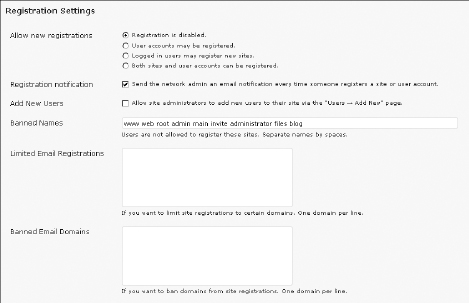
From one of the following options, decide how you want registrations to be handled on your network:
- Registration is Disabled: Disallows new user registration completely. When selected, this option prevents people who visit your site from registering for a user account.
- User Accounts May Be Registered: Gives people the ability to create only a user account; users will not be able to create a blog within your network.
- Logged In Users May Register New Sites: Allows only existing users — those who are already logged in — to create a new blog within your network. This also disables new user registration completely. You would use this option if you don't want just anyone registering for an account. Instead, you (as the site administrator) can add new users at your discretion.
- Both Sites and User Accounts Can Be Registered: Gives users the ability to register an account and a site on your network during the registration process.
These options apply only to outside users. As a network admin, you can create new sites and users any time you want by using the options in the Network Admin Dashboard. (See the information about creating new users in the upcoming “Users” section.)
The remaining options under the Registration Settings heading are as follows:
- Registration Notification: When this option is checked, an e-mail is sent to the network admin every time a user or a site is created on the system, even if the network admin creates the new site.
- Add New Users: Choose Yes or No to show whether you want to allow your community blog owners (individual site admins) to add new users to their own community blog via the Users page within their individual dashboards.
- Banned Names: By default, WordPress bans several usernames from being registered within your community, including www, web, root, admin, main, invite, administrator, and so on. For good reason, you don't want a random user to register a username, such as admin, because you don't want that person misrepresenting himself as an administrator on your site. You can enter an unlimited amount of usernames that you do not want to allow on your site in the Banned Names text box.
- Limited Email Registrations: You can limit sign-ups based on e-mail domains by filling in this text box one e-mail per line. If you have open registrations but you limited the e-mail addresses, anyone who tries to sign up who doesn't match a domain on the list will be unable to register. This is an excellent option to use in a school or corporate environment where you're providing students or employees e-mail addresses and sites.
- Banned Email Domains: This feature, the reverse of the above, blocks all sign-ups from a particular domain, which can be useful in stopping spammers. For example, you can enter gmail.com in the field, and anyone trying to sign up with a Gmail address will be denied.
New site settings
The New Site Settings section is a configurable list of items that populates default values when a new site is created. The list includes the values that display in welcome e-mails, on a user's first post page, and on a new site's first page, as shown in Figure 3-5.
- Welcome Email: The e-mail text that owners of newly registered sites in your network receive when their registration is complete. There is a default message that you can leave in place, if you like. Or, you can type the text of the e-mail you want new site owners to receive when they register a new site within your Network.
A few variables you can use in this e-mail aren't explained entirely on the Site Options page, including
- SITE_NAME: Inserts the name of your WordPress site
- BLOG_URL: Inserts the URL of the new member's blog
- USERNAME: Inserts the new member's username
- PASSWORD: Inserts the new member's password
- BLOG_URLwp-login.php: Inserts the hyperlinked login URL for the new member's blog
- SITE_URL: Inserts the hyperlinked URL for your WordPress site
- First Post: This is the first, default post that displays on every newly created site in your network. WordPress provides you with some default text that you can leave in place, or you can type your desired text in the provided text box that you want to appear in the first post on every site that's created in your community.
You can use this area to provide useful information about your site and services. This also serves as a nice guide for new users because they can view that post in their Dashboard, on the Edit Post page, to see how it was entered and formatted and then use that as a guide for creating their own blog posts. You can also use the variables mentioned in the bullet points in “Welcome Email” to have WordPress automatically add some information for you.
- First Page: Similar to the First Post setting, this default text for a default page displays on every newly created site in your network. (The First Page text box does not include default text; if you leave it blank, no default page is created.)
- First Comment: This default comment displays on the first default post on every newly created site within your network. Type the text that you want to appear in the first comment on every site that's created in your community.
- First Comment Author: Type the name of the author of the first comment on new sites in your network.
- First Comment URL: Type the Web address (URL) for the author of the first comment; this links (via hyperlink) the first comment author's name to the URL you type here.
Figure 3-5: New Site Settings on the Network Settings page.
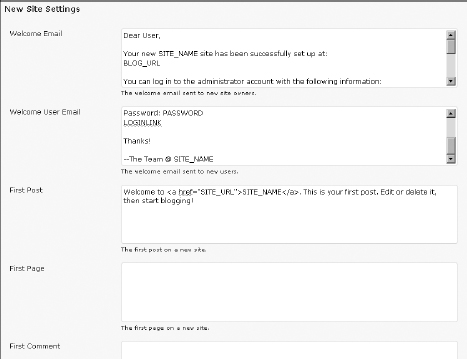
Upload settings
The Upload Settings section (see Figure 3-6) defines global values pertaining to the type of files you will allow the site owners within your network to upload using the file upload feature on the WordPress Write Posts and Write Page areas (see Book III, Chapter 4). The check boxes shown in the Media Upload Buttons under the Upload Settings section are deselected, by default. To give your network site owners the ability to upload files, place a check mark next to the name of each media type:
- Images
- Videos
- Music
Enabling the file types will display the upload icons above the post box on the Write Page and Write Post pages in the users Dashboard (see Book III, Chapter 4 for information on uploading files). In some situations, you may decide to disallow certain file types, so disabling a file type removes that file type's icon from the post editor.
The next option in the Upload Settings section is Site Upload space. The amount is in megabytes (MB), and the default storage space is 10MB. This amount of hard drive space is what you give users to store the files they upload to their blogs. If you want to change the default storage space, type a number in the text box provided.
The Upload File Types text field defines the types of files that you, as the network admin, will allow site owners to upload to their sites in their Dashboard. Users cannot upload any file types that do not appear in this text box. By default, WordPress includes the following file types: .jpg, .jpeg, .png, .gif, .mp3, .mov, .avi, .wmv, .midi, .mid, and .pdf. You can remove any default file types and add new ones.
The final option under Upload Settings defines the Max Upload file size. This amount is in kilobytes (K), and the default file size is 1500K. This means that a user cannot upload a file that is larger than 1500K. Adjust this number as you see fit by typing a new number in the text box provided.
Figure 3-6: Upload Settings on the Network Settings page.

Menu settings
The Plugins menu is disabled within the Dashboard of all network sites (except for the network admin's), as shown in Figure 3-7. However, the network admin always has access to the Plugins menu. If you leave this option unselected, the Plugins page will be visible to users on their own site dashboard. Place a check mark in the box to enable the Plugins menu for your network users. For more information about using plugins with WordPress, see Book VII.
 When you have completely finished configuring the settings on the Network Settings page, do not forget to click the Save Changes button at the bottom of the page, underneath the final Menu Settings section (see Figure 3-7). If you navigate away from the Network Settings page without clicking the Save Changes button, none of your configurations will be saved, and you'll need to go through the entire process again.
When you have completely finished configuring the settings on the Network Settings page, do not forget to click the Save Changes button at the bottom of the page, underneath the final Menu Settings section (see Figure 3-7). If you navigate away from the Network Settings page without clicking the Save Changes button, none of your configurations will be saved, and you'll need to go through the entire process again.
Figure 3-7: The Network Options page's Menu Settings section.

Sites
Clicking the Sites menu item on the Network Admin Dashboard takes you to the Sites page where you can manage your individual sites. Although each site in the network has its own Dashboard for basic tasks, such as posting, changing themes, and so on, the Sites page is where you create and delete sites and make edits to properties of the sites within your network. Editing information from this page is handy when you have issues accessing a site's back-end Dashboard.
The Sites page also lists all the sites within your network. The listing shows the following statistics about each community site:
- Path: The site's path in your network. For example, in Figure 3-8, you see a site listed with the path /newsite/. This means that the site's domain is newsite.yourdomain.com if you're using a subdomain setup, or yoursite.com/newsite if you're using a subdirectory setup).
- Last Updated: The date the site was last updated (or published to).
- Registered: The date the site was registered in your network.
- Users: The username and e-mail address associated with the user(s) of that site.
When you hover on the pathname of a site in your network, you see a handy listing of links that will help you manage the site. Figure 3-8 shows the options that appear beneath a site listing when you hover your mouse on a site name in the list.
The management options for network sites, shown in Figure 3-8, are as follows:
- Edit: A link to the Edit Site page (see Figure 3-9) where you can change aspects of each site.
- Dashboard: A link to the Dashboard of the site.
- Deactivate: Click this link to mark the site for deletion in your network; after clicking the Deactivate link, a message displays in a pop-up window that asks you to confirm your intention to deactivate the site. Click the Yes button to confirm. The user's site will display a message stating that the site has been deleted. This action can be reversed by revisiting the Sites page and clicking the Activate link that appears underneath the site pathname (the Activate link only appears underneath sites that are marked as Deactivated).
- Archive: Click this link to archive the site in your network, which prevents visitors from viewing the site and displays “This site has been archived or suspended.” This action can be reversed by revisiting the Sites page and clicking the Unarchive link that appears beneath the site's pathname. (The Unarchive link only appears beneath sites that are archived.)
- Spam: Clicking this link marks the site as spam and blocks the users from being able to access the dashboard. It also displays a message stating, “This site has been archived or suspended”. This action can be reversed by revisiting the Sites page and clicking the Not Spam link that appears underneath the site's pathname (the Not Spam link only appears underneath sites that are marked as Spam).
Figure 3-8: Individual Site Management Options on the Sites page.
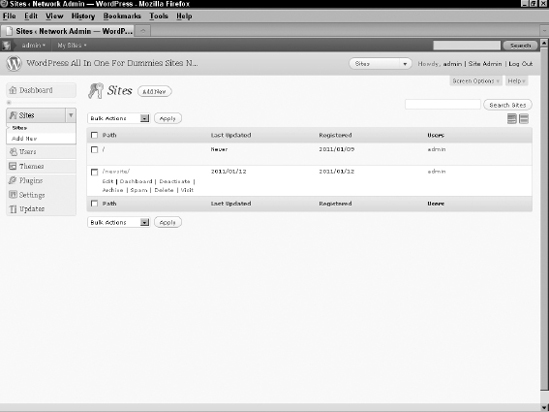
- Delete: Click this link to delete the site from your network of sites permanently. Although you see a confirmation screen that asks you to confirm your intention to delete the site, when done, you cannot reverse this decision.
- Visit: Click this link to visit the live site in your Web browser.
Figure 3-9: The Edit Site Page.
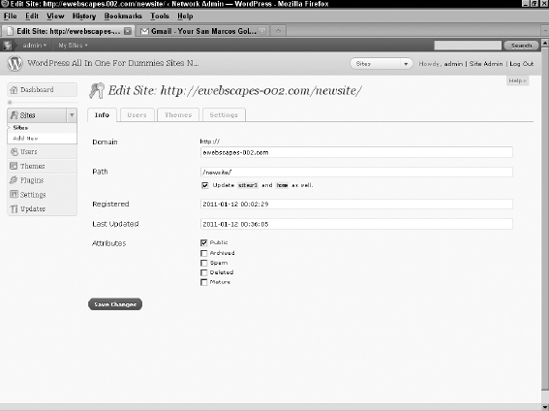
Generally, you only use the Edit Site page (refer to Figure 3-9) when the settings are unavailable from the Dashboard of that particular site, by configuring the options that appear underneath each of the four tabs on the Edit Sites page, as shown in Figure 3-9:
- Info: Under this tab, you can edit the sites domain, path, registered date, updated date and attributes (Public, Archived, Spam, Deleted, Mature).
- Users: Under this tab, you can manage the users that are assigned to the site, as well as add new users to the site under the Add New User section.
- Themes: Under this tab, you can enable themes for this site. This is particularly useful if you have themes that aren't network enabled (see the upcoming “Themes” section) because all the themes that aren't enabled within your network are listed under the Themes tab, which allows you to enable themes on a per-site basis.
- Settings: the settings under this tab cover all the database settings for the site that you are editing. Editing these settings is rare because as the network admin, you have access to each user's Dashboard and can make any changes to the site's configuration settings there.
Also in the Sites menu in the Network Admin Dashboard, you see a link called Add New — click that link to load the Add New Site page in your Network Admin Dashboard (Figure 3-10). You can create a new site from the Add New Site page, as shown in Figure 3-10. Fill in the Site Address, Site Title, and Admin Email fields and then click the Add Site button to add the new site to your network. If the admin e-mail you enter is associated with an existing user, the new site is assigned to that user in your network. If the user doesn't exist, a new user is created and an e-mail is sent with a notification. The site is immediately accessible. The e-mail the user receives contains a link to their site, a login link and their username and password.
Figure 3-10: The Add New Site page in the Network Admin Dashboard.
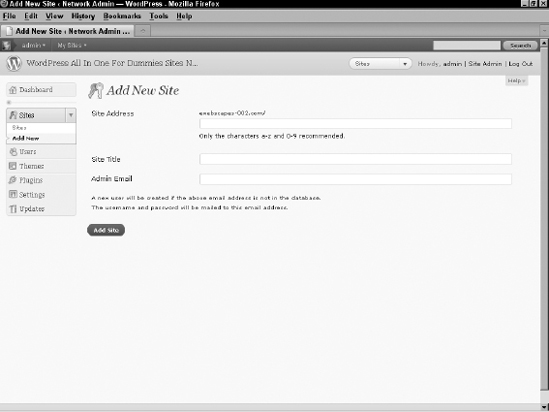
Users
Clicking the Users menu link in the Network Admin Dashboard takes you to the Users page where you see a full listing of members, or users, within your network. The Users page (see Figure 3-11) lists the following information about each user:
- Username: The login name the member uses when she logs in to her account in your community.
- Name: The user's real name, taken from her profile. If the user has not provided her name in her profile, this column will be blank.
- E-mail: The e-mail address the user entered when she registered on your site.
- Registered: The date when the user registered.
- Sites: If you enable sites within your WordPress Network, this lists any sites the user is a member of.
Similar to the Sites page, you can add and delete users to the network, and manage users, by clicking the Edit or Delete links that appear under their names when you hover on them with your mouse (the same way you do with sites on the Sites page).
To delete a user, you simply hover over the username in the list that appears on the Users page. Click the Delete link and a new screen appears with a page telling you to transfer this user's posts and links to another user account (most likely, yours). Then click the Confirm Deletion button and WordPress removes the user from the network, permanently — this action is irreversible, so be certain about your decision before you click that button!
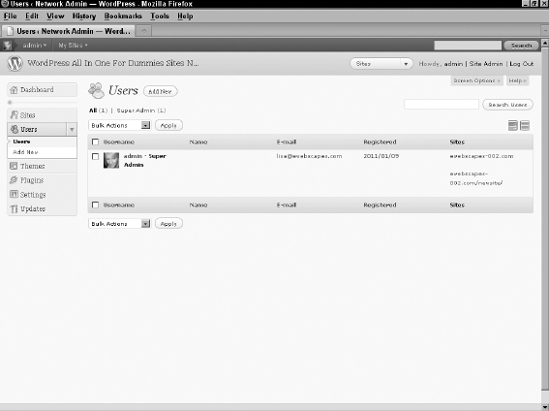
You can also edit a user's profile information by clicking the Edit link that appears when you hover your mouse on his name on the Users page. Clicking that link takes you to the Edit User page, shown in Figure 3-12, where you are presented with several options, which just happen to (mostly) be the very same options and setting that you configured for your own profile information back in Book III, Chapter 3.
The only difference with the Edit User page within the Network Admin Dashboard is the setting labeled Super Admin — deselected by default. However, if you select this box, you grant this user network admin privileges for your network. This means that the user has the exact same access and permission as you.
![]() At the time of this writing, the terms super admin and network admin are interchangeable. When WordPress merged the WordPress MU code base with the regular WordPress software, the term they used to describe the network admin was super admin. Now, network admin is the standard term; however, areas within the Network Admin Dashboard and regular Dashboard still use Super Admin as a label. We will most likely see that change in the very near future because WordPress will realize the discrepancy and update later versions of the software.
At the time of this writing, the terms super admin and network admin are interchangeable. When WordPress merged the WordPress MU code base with the regular WordPress software, the term they used to describe the network admin was super admin. Now, network admin is the standard term; however, areas within the Network Admin Dashboard and regular Dashboard still use Super Admin as a label. We will most likely see that change in the very near future because WordPress will realize the discrepancy and update later versions of the software.
Figure 3-12: The Edit Users page.
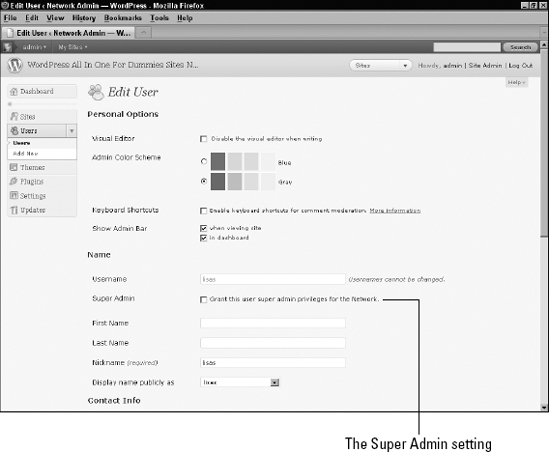
Also in the Users menu in the Network Admin Dashboard, you see a link called Add New — click that link to load the Add New User page in your Network Admin Dashboard (Figure 3-13).
You can add a new user from the Add New User page, by filling in the username and e-mail of the user you want to add and then clicking the Add User button. The new user is sent an e-mail notification alerting them of the new account, along with the site URL, their username and password (randomly generated by WordPress at the time the user account is created).
Figure 3-13: The Add New User page in the Network Admin Dashboard.
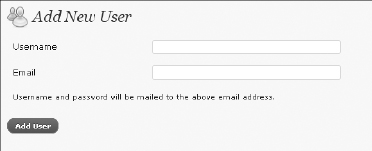
Themes
When a network is enabled, only users with network admin access have permission to install themes, which are shared across the network. You can review details on how to find, install, and activate new themes with your WordPress installation in Book VI, Chapters 1 and 2. After you install a theme, you must enable it in your network in order for the theme to appear in the Appearance menu of each site, where users in your network can activate it on their site. To access the Network Themes page (shown in Figure 3-14), click the Themes link under the Themes menu on the Network Admin Dashboard.
![]() In Chapter 5 of this minibook, we show you how to enable a theme on a per-site basis.
In Chapter 5 of this minibook, we show you how to enable a theme on a per-site basis.
Plugins
Most WordPress plugins will work on your network. There are, however, some special plugins and some special considerations for using plugins with a network.
![]() First, if you need a refresher on how to find, install, and activate plugins in WordPress, page back through and find Book VII, Chapters 1 and 2 for this information.
First, if you need a refresher on how to find, install, and activate plugins in WordPress, page back through and find Book VII, Chapters 1 and 2 for this information.
Figure 3-14: The Network Themes page.
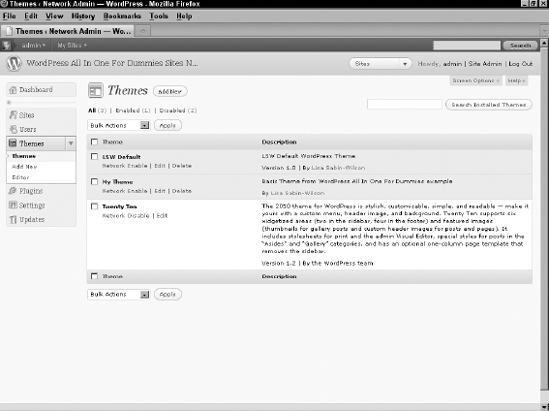
Browse to the Plugins page in your WordPress Network Admin Dashboard by clicking the Plugins link under the Plugins menu. You find that the Plugins page is just as we describe in Book VII, Chapter 1, but you could easily miss one very small, subtle difference if you don't know where to look. Check out Figure 3-15 below the name of the plugin. Do you see the Network Activate link? That is the big difference between plugins listed in the regular Dashboard and the Network Admin Dashboard. As the network admin, you can enable certain plugins to be activated globally, across your entire network. This means that all sites in your network will have the network-activated plugin features available. (Plugins that you activate on the regular Dashboard {under Site Admin} are only activated and available for your main Web site.)
![]() Earlier in this chapter in the Settings: Menu Settings section, if you select the Plugins menu, then users see the plugins listed on their Plugins page in their Dashboard. In their list of plugins, they only see the plugins that you have not network activated; rather, they see a list of all the plugins you installed in your WordPress installation, but none of them are activated on that user's site. The user has the ability to activate, and deactivate, those plugins as they desire.
Earlier in this chapter in the Settings: Menu Settings section, if you select the Plugins menu, then users see the plugins listed on their Plugins page in their Dashboard. In their list of plugins, they only see the plugins that you have not network activated; rather, they see a list of all the plugins you installed in your WordPress installation, but none of them are activated on that user's site. The user has the ability to activate, and deactivate, those plugins as they desire.
Figure 3-15: The Network Plugins page.
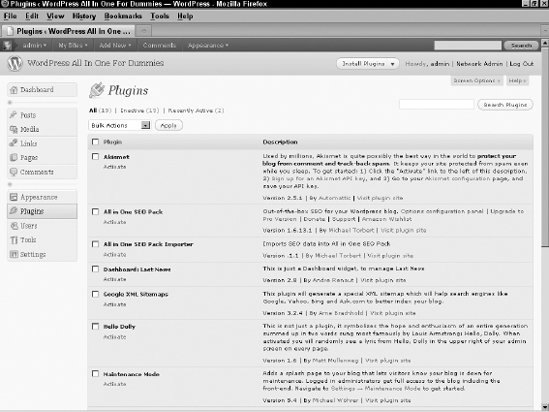
Network admins are the only people who can install new plugins on the site; regular users within the network do not have that kind of access (unless you made them a network admin in their User settings).
Also located in the Plugins menu in the Network Admin Dashboard are two other links: Add New and Editor. This is where you can add and install new plugins by searching the WordPress Plugin Directory within your Dashboard (we cover this in Book VII, Chapters 1 and 2), and the Editor link gives you access to the Plugin Editor, covered in Book VII, Chapter 4.
Updates
Clicking the Updates link on the Network Admin Dashboard menu gives you access to the WordPress Updates page, which takes you through the same process of upgrading your WordPress installation software as we describe in Book II, Chapter 6. (In fact, the page looks the same as the one we show you in Book II, Chapter 6.) However, with a network site, WordPress takes the extra step of upgrading all sites within your network so they all use the same, upgraded feature sets.
If the process of upgrading network sites stalls or stops, the URL of the last site upgraded displays on the WordPress Updates page. The network admin can access the dashboard of the site where the upgrade stopped, which usually clears up the issue. A user accessing their site Dashboard after an upgrade also triggers this process.
